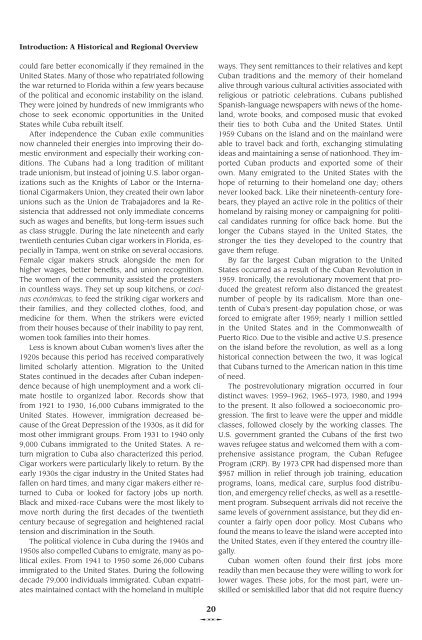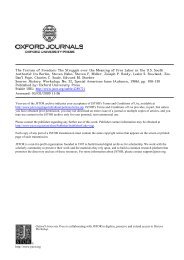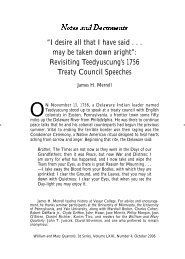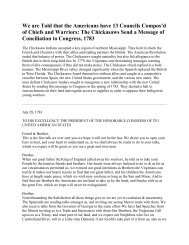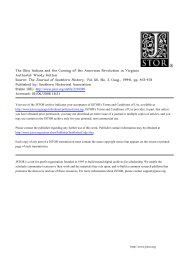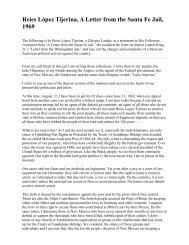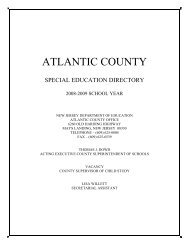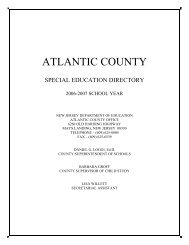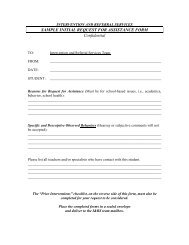A Historical and Regional Overview of Latinas in the United ... - CUNY
A Historical and Regional Overview of Latinas in the United ... - CUNY
A Historical and Regional Overview of Latinas in the United ... - CUNY
Create successful ePaper yourself
Turn your PDF publications into a flip-book with our unique Google optimized e-Paper software.
Introduction: A <strong>Historical</strong> <strong>and</strong> <strong>Regional</strong> <strong>Overview</strong><br />
could fare better economically if <strong>the</strong>y rema<strong>in</strong>ed <strong>in</strong> <strong>the</strong><br />
<strong>United</strong> States. Many <strong>of</strong> those who repatriated follow<strong>in</strong>g<br />
<strong>the</strong> war returned to Florida with<strong>in</strong> a few years because<br />
<strong>of</strong> <strong>the</strong> political <strong>and</strong> economic <strong>in</strong>stability on <strong>the</strong> isl<strong>and</strong>.<br />
They were jo<strong>in</strong>ed by hundreds <strong>of</strong> new immigrants who<br />
chose to seek economic opportunities <strong>in</strong> <strong>the</strong> <strong>United</strong><br />
States while Cuba rebuilt itself.<br />
After <strong>in</strong>dependence <strong>the</strong> Cuban exile communities<br />
now channeled <strong>the</strong>ir energies <strong>in</strong>to improv<strong>in</strong>g <strong>the</strong>ir domestic<br />
environment <strong>and</strong> especially <strong>the</strong>ir work<strong>in</strong>g conditions.<br />
The Cubans had a long tradition <strong>of</strong> militant<br />
trade unionism, but <strong>in</strong>stead <strong>of</strong> jo<strong>in</strong><strong>in</strong>g U.S. labor organizations<br />
such as <strong>the</strong> Knights <strong>of</strong> Labor or <strong>the</strong> International<br />
Cigarmakers Union, <strong>the</strong>y created <strong>the</strong>ir own labor<br />
unions such as <strong>the</strong> Union de Trabajadores <strong>and</strong> la Resistencia<br />
that addressed not only immediate concerns<br />
such as wages <strong>and</strong> benefits, but long-term issues such<br />
as class struggle. Dur<strong>in</strong>g <strong>the</strong> late n<strong>in</strong>eteenth <strong>and</strong> early<br />
twentieth centuries Cuban cigar workers <strong>in</strong> Florida, especially<br />
<strong>in</strong> Tampa, went on strike on several occasions.<br />
Female cigar makers struck alongside <strong>the</strong> men for<br />
higher wages, better benefits, <strong>and</strong> union recognition.<br />
The women <strong>of</strong> <strong>the</strong> community assisted <strong>the</strong> protesters<br />
<strong>in</strong> countless ways. They set up soup kitchens, or coc<strong>in</strong>as<br />
económicas, to feed <strong>the</strong> strik<strong>in</strong>g cigar workers <strong>and</strong><br />
<strong>the</strong>ir families, <strong>and</strong> <strong>the</strong>y collected clo<strong>the</strong>s, food, <strong>and</strong><br />
medic<strong>in</strong>e for <strong>the</strong>m. When <strong>the</strong> strikers were evicted<br />
from <strong>the</strong>ir houses because <strong>of</strong> <strong>the</strong>ir <strong>in</strong>ability to pay rent,<br />
women took families <strong>in</strong>to <strong>the</strong>ir homes.<br />
Less is known about Cuban women’s lives after <strong>the</strong><br />
1920s because this period has received comparatively<br />
limited scholarly attention. Migration to <strong>the</strong> <strong>United</strong><br />
States cont<strong>in</strong>ued <strong>in</strong> <strong>the</strong> decades after Cuban <strong>in</strong>dependence<br />
because <strong>of</strong> high unemployment <strong>and</strong> a work climate<br />
hostile to organized labor. Records show that<br />
from 1921 to 1930, 16,000 Cubans immigrated to <strong>the</strong><br />
<strong>United</strong> States. However, immigration decreased because<br />
<strong>of</strong> <strong>the</strong> Great Depression <strong>of</strong> <strong>the</strong> 1930s, as it did for<br />
most o<strong>the</strong>r immigrant groups. From 1931 to 1940 only<br />
9,000 Cubans immigrated to <strong>the</strong> <strong>United</strong> States. A return<br />
migration to Cuba also characterized this period.<br />
Cigar workers were particularly likely to return. By <strong>the</strong><br />
early 1930s <strong>the</strong> cigar <strong>in</strong>dustry <strong>in</strong> <strong>the</strong> <strong>United</strong> States had<br />
fallen on hard times, <strong>and</strong> many cigar makers ei<strong>the</strong>r returned<br />
to Cuba or looked for factory jobs up north.<br />
Black <strong>and</strong> mixed-race Cubans were <strong>the</strong> most likely to<br />
move north dur<strong>in</strong>g <strong>the</strong> first decades <strong>of</strong> <strong>the</strong> twentieth<br />
century because <strong>of</strong> segregation <strong>and</strong> heightened racial<br />
tension <strong>and</strong> discrim<strong>in</strong>ation <strong>in</strong> <strong>the</strong> South.<br />
The political violence <strong>in</strong> Cuba dur<strong>in</strong>g <strong>the</strong> 1940s <strong>and</strong><br />
1950s also compelled Cubans to emigrate, many as political<br />
exiles. From 1941 to 1950 some 26,000 Cubans<br />
immigrated to <strong>the</strong> <strong>United</strong> States. Dur<strong>in</strong>g <strong>the</strong> follow<strong>in</strong>g<br />
decade 79,000 <strong>in</strong>dividuals immigrated. Cuban expatriates<br />
ma<strong>in</strong>ta<strong>in</strong>ed contact with <strong>the</strong> homel<strong>and</strong> <strong>in</strong> multiple<br />
20<br />
q<br />
ways. They sent remittances to <strong>the</strong>ir relatives <strong>and</strong> kept<br />
Cuban traditions <strong>and</strong> <strong>the</strong> memory <strong>of</strong> <strong>the</strong>ir homel<strong>and</strong><br />
alive through various cultural activities associated with<br />
religious or patriotic celebrations. Cubans published<br />
Spanish-language newspapers with news <strong>of</strong> <strong>the</strong> homel<strong>and</strong>,<br />
wrote books, <strong>and</strong> composed music that evoked<br />
<strong>the</strong>ir ties to both Cuba <strong>and</strong> <strong>the</strong> <strong>United</strong> States. Until<br />
1959 Cubans on <strong>the</strong> isl<strong>and</strong> <strong>and</strong> on <strong>the</strong> ma<strong>in</strong>l<strong>and</strong> were<br />
able to travel back <strong>and</strong> forth, exchang<strong>in</strong>g stimulat<strong>in</strong>g<br />
ideas <strong>and</strong> ma<strong>in</strong>ta<strong>in</strong><strong>in</strong>g a sense <strong>of</strong> nationhood. They imported<br />
Cuban products <strong>and</strong> exported some <strong>of</strong> <strong>the</strong>ir<br />
own. Many emigrated to <strong>the</strong> <strong>United</strong> States with <strong>the</strong><br />
hope <strong>of</strong> return<strong>in</strong>g to <strong>the</strong>ir homel<strong>and</strong> one day; o<strong>the</strong>rs<br />
never looked back. Like <strong>the</strong>ir n<strong>in</strong>eteenth-century forebears,<br />
<strong>the</strong>y played an active role <strong>in</strong> <strong>the</strong> politics <strong>of</strong> <strong>the</strong>ir<br />
homel<strong>and</strong> by rais<strong>in</strong>g money or campaign<strong>in</strong>g for political<br />
c<strong>and</strong>idates runn<strong>in</strong>g for <strong>of</strong>fice back home. But <strong>the</strong><br />
longer <strong>the</strong> Cubans stayed <strong>in</strong> <strong>the</strong> <strong>United</strong> States, <strong>the</strong><br />
stronger <strong>the</strong> ties <strong>the</strong>y developed to <strong>the</strong> country that<br />
gave <strong>the</strong>m refuge.<br />
By far <strong>the</strong> largest Cuban migration to <strong>the</strong> <strong>United</strong><br />
States occurred as a result <strong>of</strong> <strong>the</strong> Cuban Revolution <strong>in</strong><br />
1959. Ironically, <strong>the</strong> revolutionary movement that produced<br />
<strong>the</strong> greatest reform also distanced <strong>the</strong> greatest<br />
number <strong>of</strong> people by its radicalism. More than onetenth<br />
<strong>of</strong> Cuba’s present-day population chose, or was<br />
forced to emigrate after 1959; nearly 1 million settled<br />
<strong>in</strong> <strong>the</strong> <strong>United</strong> States <strong>and</strong> <strong>in</strong> <strong>the</strong> Commonwealth <strong>of</strong><br />
Puerto Rico. Due to <strong>the</strong> visible <strong>and</strong> active U.S. presence<br />
on <strong>the</strong> isl<strong>and</strong> before <strong>the</strong> revolution, as well as a long<br />
historical connection between <strong>the</strong> two, it was logical<br />
that Cubans turned to <strong>the</strong> American nation <strong>in</strong> this time<br />
<strong>of</strong> need.<br />
The postrevolutionary migration occurred <strong>in</strong> four<br />
dist<strong>in</strong>ct waves: 1959–1962, 1965–1973, 1980, <strong>and</strong> 1994<br />
to <strong>the</strong> present. It also followed a socioeconomic progression.<br />
The first to leave were <strong>the</strong> upper <strong>and</strong> middle<br />
classes, followed closely by <strong>the</strong> work<strong>in</strong>g classes. The<br />
U.S. government granted <strong>the</strong> Cubans <strong>of</strong> <strong>the</strong> first two<br />
waves refugee status <strong>and</strong> welcomed <strong>the</strong>m with a comprehensive<br />
assistance program, <strong>the</strong> Cuban Refugee<br />
Program (CRP). By 1973 CPR had dispensed more than<br />
$957 million <strong>in</strong> relief through job tra<strong>in</strong><strong>in</strong>g, education<br />
programs, loans, medical care, surplus food distribution,<br />
<strong>and</strong> emergency relief checks, as well as a resettlement<br />
program. Subsequent arrivals did not receive <strong>the</strong><br />
same levels <strong>of</strong> government assistance, but <strong>the</strong>y did encounter<br />
a fairly open door policy. Most Cubans who<br />
found <strong>the</strong> means to leave <strong>the</strong> isl<strong>and</strong> were accepted <strong>in</strong>to<br />
<strong>the</strong> <strong>United</strong> States, even if <strong>the</strong>y entered <strong>the</strong> country illegally.<br />
Cuban women <strong>of</strong>ten found <strong>the</strong>ir first jobs more<br />
readily than men because <strong>the</strong>y were will<strong>in</strong>g to work for<br />
lower wages. These jobs, for <strong>the</strong> most part, were unskilled<br />
or semiskilled labor that did not require fluency


